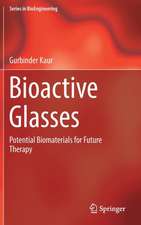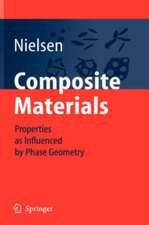Springer Handbook of Nanomaterials: Springer Handbooks
Editat de Robert Vajtaien Limba Engleză Hardback – 9 sep 2013
Din seria Springer Handbooks
- 18%
 Preț: 1910.19 lei
Preț: 1910.19 lei - 18%
 Preț: 1989.90 lei
Preț: 1989.90 lei - 18%
 Preț: 2319.75 lei
Preț: 2319.75 lei - 18%
 Preț: 2199.82 lei
Preț: 2199.82 lei - 18%
 Preț: 2281.24 lei
Preț: 2281.24 lei - 18%
 Preț: 1749.98 lei
Preț: 1749.98 lei - 23%
 Preț: 1919.43 lei
Preț: 1919.43 lei - 23%
 Preț: 1963.79 lei
Preț: 1963.79 lei - 18%
 Preț: 1984.38 lei
Preț: 1984.38 lei - 18%
 Preț: 2011.02 lei
Preț: 2011.02 lei - 18%
 Preț: 2292.94 lei
Preț: 2292.94 lei - 18%
 Preț: 1999.50 lei
Preț: 1999.50 lei - 18%
 Preț: 2331.60 lei
Preț: 2331.60 lei - 20%
 Preț: 2105.30 lei
Preț: 2105.30 lei - 18%
 Preț: 2016.72 lei
Preț: 2016.72 lei - 18%
 Preț: 1717.73 lei
Preț: 1717.73 lei - 18%
 Preț: 2292.28 lei
Preț: 2292.28 lei - 18%
 Preț: 2197.46 lei
Preț: 2197.46 lei - 18%
 Preț: 1991.47 lei
Preț: 1991.47 lei - 18%
 Preț: 1759.26 lei
Preț: 1759.26 lei - 18%
 Preț: 2007.40 lei
Preț: 2007.40 lei - 18%
 Preț: 2041.19 lei
Preț: 2041.19 lei - 18%
 Preț: 2063.42 lei
Preț: 2063.42 lei - 18%
 Preț: 2214.82 lei
Preț: 2214.82 lei - 18%
 Preț: 2175.01 lei
Preț: 2175.01 lei - 18%
 Preț: 1978.03 lei
Preț: 1978.03 lei - 18%
 Preț: 2108.41 lei
Preț: 2108.41 lei - 18%
 Preț: 2002.53 lei
Preț: 2002.53 lei - 18%
 Preț: 2173.76 lei
Preț: 2173.76 lei - 18%
 Preț: 2009.64 lei
Preț: 2009.64 lei - 18%
 Preț: 2289.15 lei
Preț: 2289.15 lei - 18%
 Preț: 2033.29 lei
Preț: 2033.29 lei - 20%
 Preț: 2087.48 lei
Preț: 2087.48 lei - 18%
 Preț: 2184.03 lei
Preț: 2184.03 lei - 23%
 Preț: 1959.73 lei
Preț: 1959.73 lei - 23%
 Preț: 1806.45 lei
Preț: 1806.45 lei - 23%
 Preț: 1865.18 lei
Preț: 1865.18 lei - 23%
 Preț: 1436.52 lei
Preț: 1436.52 lei - 23%
 Preț: 1591.60 lei
Preț: 1591.60 lei - 23%
 Preț: 1840.29 lei
Preț: 1840.29 lei - 14%
 Preț: 1223.33 lei
Preț: 1223.33 lei - 14%
 Preț: 1223.33 lei
Preț: 1223.33 lei - 20%
 Preț: 1892.94 lei
Preț: 1892.94 lei - 34%
 Preț: 1602.73 lei
Preț: 1602.73 lei - 14%
 Preț: 1223.33 lei
Preț: 1223.33 lei - 29%
 Preț: 1463.99 lei
Preț: 1463.99 lei
Preț: 1994.63 lei
Preț vechi: 2432.48 lei
-18% Nou
Puncte Express: 2992
Preț estimativ în valută:
381.71€ • 396.10$ • 319.05£
381.71€ • 396.10$ • 319.05£
Carte disponibilă
Livrare economică 22 februarie-08 martie
Preluare comenzi: 021 569.72.76
Specificații
ISBN-13: 9783642205941
ISBN-10: 3642205941
Pagini: 1500
Ilustrații: XXXVI, 1221 p. 685 illus. in color.
Dimensiuni: 193 x 242 x 58 mm
Greutate: 2.43 kg
Ediția:2013
Editura: Springer Berlin, Heidelberg
Colecția Springer
Seria Springer Handbooks
Locul publicării:Berlin, Heidelberg, Germany
ISBN-10: 3642205941
Pagini: 1500
Ilustrații: XXXVI, 1221 p. 685 illus. in color.
Dimensiuni: 193 x 242 x 58 mm
Greutate: 2.43 kg
Ediția:2013
Editura: Springer Berlin, Heidelberg
Colecția Springer
Seria Springer Handbooks
Locul publicării:Berlin, Heidelberg, Germany
Public țintă
Professional/practitionerCuprins
Forewords by Claes-Göran Granqvist, Uppsala University, Sweden, and Neal F. Lane, Rice University, Texas.- Part A NanoCarbons.- Part B NanoMetals.- Part C NanoCeramics.- Part D NanoSemiconductors.- Part E Nanocomposites and Solutions.- Part F Nanoporous Materials.- Part G Organic and Bio Nanomaterials.- Part H Applications and Impact Acknowledgements.
Part A NanoCarbons.- Part B NanoMetals.- Part C NanoCeramics.- Part D NanoSemiconductors.- Part E Nanocomposites and Solutions.- Part F Nanoporous Materials.- Part G Organic and Bio Nanomaterials.- Part H Applications and Impact Acknowledgements.
Part A NanoCarbons.- Part B NanoMetals.- Part C NanoCeramics.- Part D NanoSemiconductors.- Part E Nanocomposites and Solutions.- Part F Nanoporous Materials.- Part G Organic and Bio Nanomaterials.- Part H Applications and Impact Acknowledgements.
Recenzii
“This is the best and most comprehensive singlesource book on nanotechnology involving the chemistry, biophysics, and tissueengineering of nanoparticles, nanotubes, nanofilaments, and ceramics. … Thebook is of great value for biochemists, inorganic physical chemists,engineerings, biomedical researchers, students, and physicians at variouslevels of the training cycles. It may be a standard text for the next severalyears.” (Joseph J. Grenier, Amazon.com, February, 2016)
Notă biografică
Robert Vajtai is a Faculty Fellow in the Department of Mechanical Engineering & Materials Science at Rice University, Houston, USA. His scientific interests cover synthesis, processing, and characterization of physical and chemical properties of new material forms and structures, mainly nanostructured materials, nanocomposites and nanomaterials; as well as applications of these materials in thermal management, energy storage, MEMS, and electronic devices.
He received his MS degree in Physics and his Doctor’s degree in Solid-State Physics from the University of Szeged, Hungary, in 1986 and 1997, respectively. From 1987 to 2002 he was a Faculty Member of the Experimental Physics Department of Szeged University, Hungary. He also spent sabbatical time as a Fellow of the Swedish Institute in The Ångstrom Laboratory in Uppsala, Sweden, from 1998 to 1999; as an Eötvös Fellow at the EPFL in Lausanne, Switzerland from 1995 to 1996 and he also visited the Max Planck Institute in Göttingen, Germany in 1993 via a Max Planck Fellowship. He was rewarded by the Bolyai Fellowship of the Hungarian Scientific Academy for 1999-2000.
Before joining Rice University, Dr. Vajtai spent eight years at the Rensselaer Polytechnic Institute, where he was a Laboratory Manager at the Rensselaer Nanotechnology Center managing the nanoparticle generation by inert-gas deposition and the carbon nanotechnology laboratories. Dr. Vajtai is on the Editorial Board of the journals Nanopages and Fluctuations and Noise Letters.
He received his MS degree in Physics and his Doctor’s degree in Solid-State Physics from the University of Szeged, Hungary, in 1986 and 1997, respectively. From 1987 to 2002 he was a Faculty Member of the Experimental Physics Department of Szeged University, Hungary. He also spent sabbatical time as a Fellow of the Swedish Institute in The Ångstrom Laboratory in Uppsala, Sweden, from 1998 to 1999; as an Eötvös Fellow at the EPFL in Lausanne, Switzerland from 1995 to 1996 and he also visited the Max Planck Institute in Göttingen, Germany in 1993 via a Max Planck Fellowship. He was rewarded by the Bolyai Fellowship of the Hungarian Scientific Academy for 1999-2000.
Before joining Rice University, Dr. Vajtai spent eight years at the Rensselaer Polytechnic Institute, where he was a Laboratory Manager at the Rensselaer Nanotechnology Center managing the nanoparticle generation by inert-gas deposition and the carbon nanotechnology laboratories. Dr. Vajtai is on the Editorial Board of the journals Nanopages and Fluctuations and Noise Letters.
Textul de pe ultima copertă
Forewords by Claes-Göran Granqvist, Uppsala University, Sweden, and Neal F. Lane, Rice University, Texas
Nanomaterials inevitably have bright prospects, but even now they play an important role in many areas of industry. Some of these new materials are commercially available and are used in off the shelf products, others are important model systems for physicochemical and materials science research. However, research findings and application data are not compiled in a single work. The Springer Handbook of Nanomaterials collects description and data of materials which have dimensions on the nanoscale. The description of nanomaterials follows the interplay of structure, properties, processing and applications mainly in their solid phase. The chapters were arranged according to the classical materials-science classifications: carbon materials, metals, ceramics, composites, and biomaterials. For each part, materials structures represent different dimensionality; zero-dimensional clusters, nanoparticles and quantum dots, one-dimensional nanowires and nanotubes, and two-dimensional thin films and surfaces. Combinations cover for instance nanostructured and hybrid materials.
Almost 100 leading scientists from academia and the industry were selected to write the 32 chapters and collect the physical, chemical and mechanical data. The handbook was written and compiled for professionals and practitioners, materials scientists, physicists and chemists at universities, as well as in the fields of industrial research and production.
The Handbook is organized in seven parts. Part A: NanoCarbons. Part B: NanoMetals. Part C: NanoCeramics. Part D: NanoComposits. Part E: Nanoporous Materials. Part F: Organic and Biomaterilas. Part G: Applications and Impact.
Key Topics
Nanomaterials inevitably have bright prospects, but even now they play an important role in many areas of industry. Some of these new materials are commercially available and are used in off the shelf products, others are important model systems for physicochemical and materials science research. However, research findings and application data are not compiled in a single work. The Springer Handbook of Nanomaterials collects description and data of materials which have dimensions on the nanoscale. The description of nanomaterials follows the interplay of structure, properties, processing and applications mainly in their solid phase. The chapters were arranged according to the classical materials-science classifications: carbon materials, metals, ceramics, composites, and biomaterials. For each part, materials structures represent different dimensionality; zero-dimensional clusters, nanoparticles and quantum dots, one-dimensional nanowires and nanotubes, and two-dimensional thin films and surfaces. Combinations cover for instance nanostructured and hybrid materials.
Almost 100 leading scientists from academia and the industry were selected to write the 32 chapters and collect the physical, chemical and mechanical data. The handbook was written and compiled for professionals and practitioners, materials scientists, physicists and chemists at universities, as well as in the fields of industrial research and production.
The Handbook is organized in seven parts. Part A: NanoCarbons. Part B: NanoMetals. Part C: NanoCeramics. Part D: NanoComposits. Part E: Nanoporous Materials. Part F: Organic and Biomaterilas. Part G: Applications and Impact.
Key Topics
- Graphene, Fullerenes, Nanotubes, Diamonds, Bionanomaterials
- Noble and Common Metals, Alloys, Magnetic Nanostructures
- Piezoelectrics, Graphite Oxide, Crystals, Glasses, Polymers, Dispersions
- Silicon, Zeolites, Anodic Aluminum Oxide
- Applications in Energy, Civil Engineering, Nanomedicine, Nanofiltering
- Toxicology, Hazards and Safety
- Covers basic concepts, materials, properties, and fabrication
- Contains over 700 color illustrations
- Numerous comprehensive data tables
- Features exhaustive references to approved data
- Concise, clear and coherent presentation
- All chapters with summaries
- Application-oriented contents
Caracteristici
Meets the need for a comprehensive, easily accessible source of application-oriented, authoritative information by integrating knowledge from key subfields Highly detailed single-volume treatment of a rapidly evolving field Includes supplementary material: sn.pub/extras


















